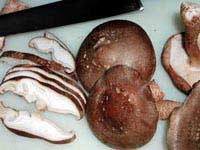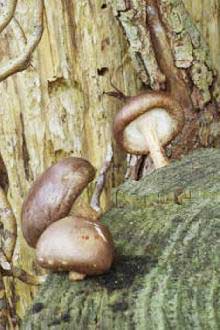1. Biological Characteristics of Shiitake Mushrooms
 |
|
Shiitake Mushroom |
Shiitake mushrooms, scientifically known as Lentinus edodes, are a type of saprophytic fungus that grows on wood, thriving in temperate climates. The temperature for fruiting body formation and development is around 15-16oC, while the growth phase of the mycelium (mycelial phase) requires approximately 24-26oC.
-
Substrate moisture: 65-70%
-
Air humidity: ≥ 80%
-
Neutral pH.
-
Light is not necessary during the mycelial growth phase. Diffused light is needed during the fruiting body formation stage.
-
Moderate ventilation.
Nutrition: Shiitake mushrooms utilize cellulose directly when they exhibit a light pink color, and the complete fruiting bodies are characterized by distinct parts: stem, veil, gills, and cap. The size and shape of the fruiting bodies vary depending on the strain of shiitake. Shiitake mushrooms have been naturally harvested and cultivated for a long time, known for their delicious flavor and aroma, making them a popular choice among many. Currently, Japan, China, and South Korea are the leading producers of shiitake mushrooms globally, with an annual production exceeding 1 million tons. The mushrooms are primarily consumed in fresh and dried forms.
2. Cultivating Shiitake Mushrooms on Sawdust
a. Preparing Materials:
– Select sawdust that is free from essential oils, mold, and toxins (oils, chemicals, etc.). Moisture content should reach 70%. Pile the sawdust in quantities of at least 300 kg per pile. The stacking process should last for 4-6 days, turning it once every 2-3 days.
– After the sawdust has been stacked, mix in 3% calcium carbonate (CaCO3) or 1.5% hydrated lime, and package it in heat-resistant plastic bags. The bags should be 25 cm wide and 40 cm high, with a weight of 1.5 kg per bag. Seal the bag’s neck with a plastic tube and cotton, and then sterilize the sawdust bags using one of the following methods:
– Steam in a barrel or construct a furnace with a cast iron pan at the bottom, wrapping it with metal sheets insulated with fiberglass, and brick it outside. Use charcoal or firewood as fuel. Place the sawdust bags in a steam bath at 100oC for 10-12 hours from the time it begins boiling.
– Alternatively, sterilize the sawdust bags in an autoclave at 121oC for 90 minutes.
b. Inoculating the Mushroom Spawn:
Once the sawdust bags have been sterilized, remove them to a clean room and allow them to cool. Inoculate the mushroom spawn in sterile culture cabinets into the sawdust bags at a rate of 2.5-3% of the spawn relative to the substrate (1 bottle of spawn weighing 400 g can inoculate 20-25 sawdust bags).
The average yield of mushrooms at the end of one harvesting cycle is 600-800g of fresh mushrooms per bag. The harvested mushrooms can be consumed fresh or dried at temperatures of 40-45oC. Store dried mushrooms in plastic bags, tightly sealed. In households, it is common to hang them in the kitchen attic for better preservation.
3. Cultivating Shiitake Mushrooms on Logs
a. Choosing Wood:
 |
|
Shiitake Cultivated on Logs |
Generally, any non-oily wood that is fresh and free from pests can be used to cultivate shiitake mushrooms. The most suitable types of wood for optimal growth and quality of shiitake mushrooms include oak, beech, and chestnut. At the beginning of each spring (April or October and November), proceed to cut the wood. Select straight logs and cut them into sections with a diameter of 5-20 cm and a length of 1.0-1.2 m. Avoid damaging the bark. Store the logs in a cool, clean place, and they will be ready for planting in 5-9 days.
b. Inoculating and Incubating:
– Clean the selected logs and apply a thick lime solution to both ends. Use a specialized hammer or drill to create holes in the logs, with a diameter of 1.5 cm and a depth of 3-4 cm, making holes every 15-20 cm; rows should be spaced 7-10 cm apart, with staggered holes.
Insert the mushroom spawn nearly to the top of the holes, using 3 kg of spawn per cubic meter, and cover with sawdust of the same thickness as the bark. Seal the top with a mixture of cement and spawn powder as a paste to cover the holes.
– Stack the logs in a “pigpen” style, 15-20 cm off the ground, with a height of 1.5 cm, and the length depending on the volume of wood being planted. Cover the entire stack with wet burlap sacks to retain moisture.
– Daily care of the stack mainly involves watering. The amount of water should only be enough to moisten the burlap. Do not overwater, as excessive moisture can penetrate the wood and kill the spawn. It is best to incubate for 6-16 months (depending on the type of wood). Turn the stack every 2 months to check the moisture content. If the logs are too dry, lightly spray water around the logs before re-stacking.
During the incubation period, it is essential to protect against pests that may harm the mushrooms, such as molds, insects, and rodents. Logs showing signs of disease should be isolated from the stack to prevent spreading to other logs.
c. Caring for and Harvesting Mushrooms:
At the end of the incubation period, shiitake mushrooms begin to form fruiting bodies. Look for light pink spots on the surface of the logs, which will grow larger like corn kernels and develop into complete mushrooms. Position the logs upright in a gun rack style, with rows spaced 50-60 cm apart. Logs can be arranged in a shaded, cool area with high humidity and minimal diffused light (only 3-6 months per year), which may lead to lower yields. Calculating the cultivation time to coincide with cold weather is crucial.
– When cultivating on logs, the harvesting period is only 3-6 months per year; if temperatures exceed 20oC, it is necessary to condense the logs and incubate them as initially done until the next cold cycle, continuing to water and harvest.
The best time to start planting (inoculating) shiitake mushrooms is from October to April (for planting on logs) (if planting on sawdust, from October to January of the following year).


















































